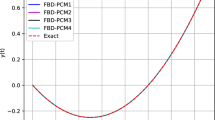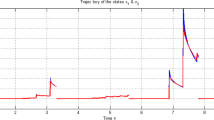Abstract
In this paper, we consider the random dichotomous fluctuations on both mass and damping in a fractional oscillator, which is subjected to an additive fractional Gaussian noise and driven by a periodic force. In order to investigate the generalized stochastic resonance (GSR) phenomena, we acquire the exact expression of the first-order moment of system’s steady response by applying generalized fractional Shapiro–Loginov formula and Laplace transform. Meanwhile, we discuss the evolutions of the output amplitude amplification (OAA) with driving frequency, noise parameters, fractional order, and damping strength. It is observed that the non-monotonic resonance behaviors of one-peak GSR, double-peak GSR and triple-peak GSR existing in this fractional system. Moreover, the interplay of mass fluctuation, damping fluctuation, and memory effect can generate a rich variety of non-equilibrium cooperation phenomena, especially the stochastic multi-resonance (SMR) behaviors. It is worth emphasizing that the triple-peak GSR was not observed in previously proposed fractional oscillator subjected to dichotomous noise. Finally, the numerical simulations are also carried out based on predictor-corrector approach to verify the effectiveness of analytic result.








Similar content being viewed by others
References
Benzi, R., Sutera, A., Vulpliani, A.: The mechanism of stochastic resonance. J. Phys. A: Math. Gen. 14, L453–457 (1981)
Gammaitoni, L., Hänggi, P., Jung, P., Marchesoni, F.: Stochastic resonance. Rev. Mod. Phys. 70, 223–287 (1998)
Wellens, T., Shatokhin, V., Buchleitners, A.: Stochastic resonance. Rep. Prog. Phys. 67, 45–105 (2004)
Chapeau-Blondeau, F., Rousseau, D.: Noise improvements in stochastic resonance: from signal amplification to optimal detection. Fluct. Noise Lett. 2, L221–233 (2002)
Ai, B., Liu, L.: Stochastic resonance in a stochastic bistable system. J. Stat. Mech. 2007, P02019 (2007)
Gitterman, M.: Classical harmonic oscillator with multiplicative noise. Physica A 352, 309–334 (2005)
McNamara, B., Wiesenfeld, K., Roy, R.: Observation of stochastic resonance in a ring laser. Phys. Rev. Lett. 60, 2626–2629 (1988)
Metzler, R., Klafter, J.: The restaurant at the end of the randomwalk: recent developments in the description of anomalous transport by fractional dynamics. J. Phys. A: Math. Gen. 37, R161C208 (2004)
Kou, S.C.: Stochastic modeling in nanoscale biophysics: subdiffusion within proteins. Ann. Appl. Stat. 2, 501C535 (2008)
Deng, W., Barkai, E.: Ergodic properties of fractional Brownian Langevinmotion. Phys. Rev. E 79, 011112 (2009)
Bao, J., Zhuo, Y.: Investigation on anomalous diffusion for nuclear fusion reactions. Phys. Rev. C 67, 233–234 (2003)
Goychuk, I.: Anomalous relaxation and dielectric response. Phys. Rev. E 76, 040102 (2007)
Lin, L., Zhou, X., Ma, H.: Subdiffusive transport of fractional two-headed molecular motor. Acta Phys. Sin. 62, 240501 (2013)
Achar, B.N.Narahari, Hanneken, J.W., Enck, T., Clarke, T.: Dynamics of the fractional oscillator. Physica A 297, 361–367 (2001)
Ryabov, Y.E., Puzenko, A.: Damped oscillations in view of the fractional oscillator equation. Phys. Rev. B 66, 553–562 (2002)
Sauga, A., Mankin, R., Ainsaar, A.: Resonant behavior of a fractional oscillator with fluctuating mass. AIP Conf. Proc. 1487, 224 (2012)
Zhong, S., Wei, K., Gao, S., Ma, H.: Trichotomous noise induced resonance behavior for a fractional oscillator with random mass. J. Stat. Phys. 159, 195–209 (2015)
Zhong, S., Yang, J., Zhang, L., Ma, H., Luo, M.: Resonant behavior of a harmonic oscillator with fluctuating mass driven by a Mittag-Leffler noise. J. Stat. Mech. 2017, 023211 (2017)
Huang, Z., Guo, F.: Stochastic resonance in a fractional linear oscillator subject to random viscous damping and signal-modulated noise. Chin. J. Phys. 54, 69–76 (2016)
Ren, R., Luo, M., Deng, K.: Stochastic resonance in a fractional oscillator subjected to multiplicative trichotomous noise. Nonlinear Dyn. 90, 379–390 (2017)
Mankin, R., Kekker, A.: Memory-enhanced energetic stability for a fractional oscillator with fluctuating frequency. Phys. Rev. E 81, 041122 (2010)
Zhong, S., Zhang, L., Wang, H., Ma, H., Luo, M.: Nonlinear effect of time delay on the generalized stochastic resonance in a fractional oscillator with multiplicative polynomial noise. Nonlinear Dyn. 89, 1327–1340 (2017)
Tian, Y., Zhong, L., He, G., Yu, T., Luo, M., Stanley, H.E.: The resonant behavior in the oscillator with double fractional-order damping under the action of nonlinear multiplicative noise. Physica A 490, 845–856 (2018)
He, G., Tian, Y., Wang, Y.: Stochastic resonance in a fractional oscillator with random damping strength and random spring stiffness. J. Stat. Mech. 2013, P09026 (2013)
Lin, L., Chen, C., Wang, H.: Trichotomous noise induced stochastic resonant in a fractional oscillator with random damping and random frequency. J. Stat. Mech. 2016, 023201 (2016)
Burov, S., Gitterman, M.: Noisy oscillator: random mass and random damping. Phys. Rev. E 94, 052144 (2016)
Landau, L.D., Lifshitz, E.M.: Statistical Physics. Pergamon, London (1958)
Kubo, R.: The fluctuation-dissipation theorem. Rep. Prog. Phys. 29, 255–284 (1966)
Gitterman, M.: New type of Brownian motion. J. Stat. Phys. 146, 239–243 (2012)
Gitterman, M.: Stochastic oscillator with random mass: new type of Brownian motion. Physica A 395, 11–21 (2014)
Wang, H., Ni, F., Lin, L., Lv, W., Zhu, H.: Transport behaviors of locally fractional coupled Brownian motors with fluctuating interactions. Physica A 505, 124–135 (2018)
Abdalla, M.S.: Time-dependent harmonic oscillator with variable mass under the action of a driving force. Phys. Rev. A 34, 4598–4605 (1986)
Ausloos, M., lambiotte, R.: Brownian particle having a fluctuating mass. Phys. Rev. E E73, 011105 (2006)
Dykman, M.I., Khasin, M., Portman, J., Shaw, S.W.: Spectrum of an oscillator with jumping frequency and the interference of partial susceptibilities. Phys. Rev. Lett. 105, 230601 (2010)
Gadomski, A., Siódmiak, J., Santamarìa-Holek, I., Rubì, J.M., Ausloos, M.: Kinetics of growth process controlled by mass-convective fluctuations and finite-size curvature effects. Acta Phys. Polon. B 36, 1537–1559 (2005)
West, B.J., Seshadri, V.: Model of gravity wave growth due to fluctuations in the air-sea coupling parameter. J. Geophys. Res. 86, 4293–4298 (1981)
Chomaz, J.M., Couarion, A.: Against the wind. Phys. Fluids 11, 2977–2983 (1999)
Helot, F., Libchaber, A.: Unidirectional crystal growth and crystal anisotropy. Phys. Scr T9, 126–129 (1985)
Saul, A., Showalter, K.: Oscillations and travel waves in chemical systems. Wiley, New York (1985)
Lutz, E.: Fractional Langevin equation. Phys. Rev. E 64, 051106 (2001)
Burov, S., Barkai, E.: Fractional Langevin equation: overdamped, underdamped and critical behaviors. Phys. Rev. E 78, 031112 (2008)
Ghosh, S.K., Cherstvy, A.G., Metzler, R.: Non-universal tracer difussion in crowded media of non-inert obstacles. Phys. Chem. Chem. Phys. 17, 1847–1858 (2015)
Liu, L., Cherstvy, A.G., Metzler, R.: Facilitated diffusion of transcription factor proteins with anomalous bulk diffusion. J. Phys. Chem. B. 121, 1284–1289 (2017)
Yu, T., Luo, M., Hua, Y.: The resonant behavior of fractional harmonic oscillator with fluctuating mass. Acta Phys. Sin. 62, 210503 (2013)
Laas, K., Mankin, R.: Resonant behavior of a fractional oscillator with random damping. AIP Conf. Proc. 1404, 131–138 (2011)
Kou, S.C., Xie, X.: Generalized Langevin equation with fractional Gaussian noise: subdiffusion within a single protein molecule. Phys. Rev. Lett. 93, 180603 (2004)
Caputo, M.: Linear models of dissipation whose Q is almost frequency independent. Geophys. J. R. Astron. Soc. 13, 529–539 (1967)
Podlubny, I.: Fractional Differential Equations. Academic Press, San Diego (1999)
Shapiro, V.E., Loginov, V.M.: Formulae of differentiation and their use for solving stochastic equations. Physica A 91, 563–574 (1978)
Oppenheim, A.V., Willsky, A.S., Nawab, S.H.: Signals and Systems. Prentice Hall, Xi’an (2012)
Burada, P.S., Schmid, G., Reguera, D., Rubi, J.M., Hänggi, P.: Double entropic stochastic resonance. Europhys. Lett. 87, 50003 (2009)
Deng, W.H.: Numerical algorithm for the time fractional Fokker-Planck equation. J. Comput. Phys. 227, 1510–1522 (2007)
Deng, W.H., Barkai, E.: Ergodic properties of fractional Brownian-Langevin motion. Phys. Rev. E 79, 011112 (2009)
Acknowledgements
This work was supported by the National Natural Science Foundation of China (No. 11701086), the Natural Science Foundation of Fujian Province (No. 2017J01550), the China Postdoctoral Science Foundation funded project (No. 2016M602047), and the Basic and Cutting-edge Research Program of Chongqing (No. cstc2017jcyjAX0412). Also, special thanks should go to Prof. Giuseppe Gaeta at Department of Mathematics, the University of Milan.
Funding
This study was funded by the National Natural Science Foundation of China (No. 11701086), the Natural Science Foundation of Fujian Province (No. 2017J01550), the China Postdoctoral Science Foundation funded project (No. 2016M602047), and the Basic and Cutting-edge Research Program of Chongqing (No. cstc2017jcyjAX0412).
Author information
Authors and Affiliations
Corresponding authors
Ethics declarations
Conflict of interest
The authors declare that they have no conflict of interest.
Additional information
Communicated by Irene Giardina.
Publisher's Note
Springer Nature remains neutral with regard to jurisdictional claims in published maps and institutional affiliations.
Appendix: The coefficients in Eq. (18)
Appendix: The coefficients in Eq. (18)
The coefficients in Eq. (18) are given by
in which, all the related parameters can be calculated by the following expressions:
Rights and permissions
About this article
Cite this article
Huang, X., Lin, L. & Wang, H. Generalized Stochastic Resonance for a Fractional Noisy Oscillator with Random Mass and Random Damping. J Stat Phys 178, 1201–1216 (2020). https://doi.org/10.1007/s10955-020-02494-3
Received:
Accepted:
Published:
Issue Date:
DOI: https://doi.org/10.1007/s10955-020-02494-3




